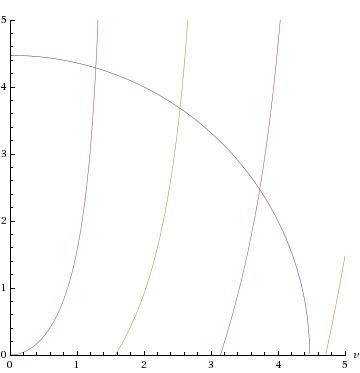 | ||
The finite potential well (also known as the finite square well) is a concept from quantum mechanics. It is an extension of the infinite potential well, in which a particle is confined to a box, but one which has finite potential walls. Unlike the infinite potential well, there is a probability associated with the particle being found outside the box. The quantum mechanical interpretation is unlike the classical interpretation, where if the total energy of the particle is less than the potential energy barrier of the walls it cannot be found outside the box. In the quantum interpretation, there is a non-zero probability of the particle being outside the box even when the energy of the particle is less than the potential energy barrier of the walls (cf quantum tunnelling).
Contents
Particle in a 1-dimensional box
For the 1-dimensional case on the x-axis, the time-independent Schrödinger equation can be written as:
where
For the case of the particle in a 1-dimensional box of length L, the potential is zero inside the box, but rises abruptly to a value
Inside the box
For the region inside the box V(x) = 0 and Equation 1 reduces to
Letting
the equation becomes
This is a well-studied differential equation and eigenvalue problem with a general solution of
Hence,
Here, A and B can be any complex numbers, and k can be any real number.
Outside the box
For the region outside of the box, since the potential is constant, V(x) =
There are two possible families of solutions, depending on whether E is less than
For a free particle, E >
produces
with the same solution form as the inside-well case:
This analysis will focus on the bound state, where
produces
where the general solution is exponential:
Similarly, for the other region outside the box:
Now in order to find the specific solution for the problem at hand, we must specify the appropriate boundary conditions and find the values for A, B, F, G, H and I that satisfy those conditions.
Finding wavefunctions for the bound state
Solutions to the Schrödinger equation must be continuous, and continuously differentiable. These requirements are boundary conditions on the differential equations previously derived.
In this case, the finite potential well is symmetrical, so symmetry can be exploited to reduce the necessary calculations.
Summarizing the previous section:
where we found
We see that as
Next, we know that the overall
These equations have two sorts of solutions, symmetric, for which
so taking the ratio gives
Similarly for the antisymmetric case we get
Recall that both
The energy equations cannot be solved analytically. Graphical or numerical solutions are aided by rewriting them a little. If we introduce the dimensionless variables
In the plot to the right, for
In this case there are exactly three solutions, since
If we want, we can go back and find the values of the constants
We note that however small
Two special cases are worth noting. As the height of the potential becomes large,
The other case is that of a very narrow, deep well - specifically the case
Note: The above derivation does not consider the possibility that the effective mass of the particle could be different inside the potential well and the region outside the well.
Spherical cavity
The results above can be used to show that, contrary to the one-dimensional case, there is not always a bound state in a spherical cavity.
The ground state of a spherically symmetric potential will always have zero orbital angular momentum, and the reduced wave function
This is identical to the one-dimensional equation, except for the boundary conditions. As before,
By comparison with the solutions above, we can see that only the antisymmetric ones have nodes at the origin. Thus only the solutions to
